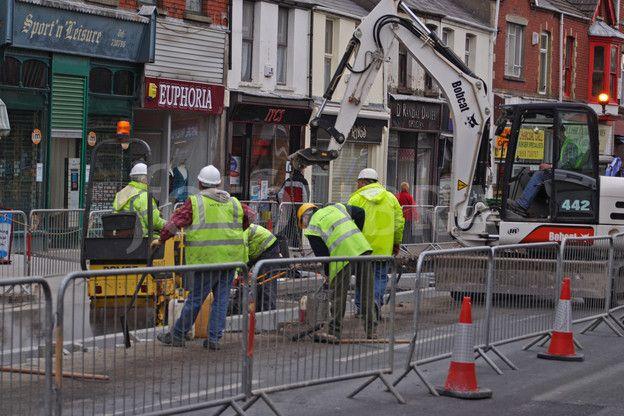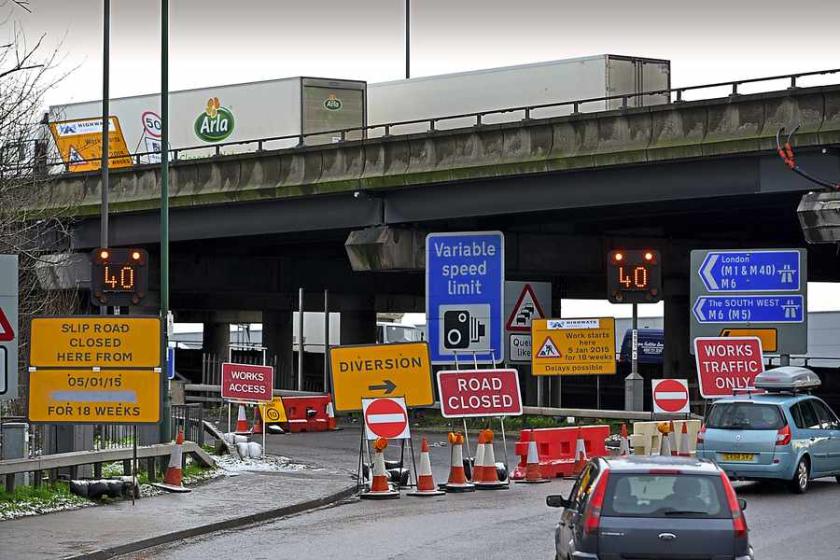They are hardly the ideal conditions in which to create. Danger is a constant and lurking menace, and it comes in multiple guises. Industrial injury is the main threat, as is the constant risk of arrest. Other hazards include deafness, breathing polluted air and public discontent. The tools and materials used in this form of installation - power drill, tarmac and steamroller - are expensive. And the work cannot be sold. But despite these powerful deterrents, a clandestine group of vagabond practitioners will stop at nothing to get their work into the public sphere. You may not know them, but you’ve certainly seen their work. It’s known, quite simply, as road art.
Road art should not be confused with its urban ancestor, street art. Where street artists paint with spray cans, principally in the vertical plane, road art is essentially a horizontal medium. The telltale sign of the road artist is a triangular semaphore with a red trim depicting a man bent over a shovel in black silhouette on a white background. If you pass one of those, you are entering a creative space. But because of the paraphernalia of road art, the huge array of equipment required to install the work - red-and-white barriers, traffic-directing signs, the heavy-duty vehicles – the work actually produced by road artists is itself very rarely appreciated.
So what is road art? Essentially it consists of a series of seemingly random interruptions of the smooth surface of the public highway. These intervenings can take many forms. The simplest manifestation of entry-level road art is a strip of coal-black tarmac running the length of some faded grey tarmac for an unspecified length.
But road art is by no means restricted to monochrome. Bus lanes and cycle lanes both allow the road artist to vary his palette (and it invariably is his, not hers: road artists are always male - see below). Often laid out by local councils in attractive designs of, say, rage red or municipal tennis court green, dedicated bus routes and cycle lanes afford the road artist almost unlimited opportunities to mix colours.
It shouldn’t be supposed that road art is created only in two dimensions. The most sophisticated road artists explore subtle, and sometimes unsubtle, variegations in texture and form. The more advanced examples introduce corrugations and ructions into the worked surface. These take the shape of potholes, manholes, and sinkholes. The full scope of a road artist’s experimentation with three-dimensionality is best understood by cyclists, who can appreciate road art both visually and rectally, the latter through the medium of the bike seat. In the video below, note the careful management of contour and line, the conceptualised palette and expert interplay of street ruttings.
What is road art? This is road art:
So that in a nutshell is what road art is. But what’s it for? Who does it? And, when all’s said and done, why? It’s a quirk of this particular form of art that art critics and connoisseurs are never invited to cast judgement on the work. There are no openings, no galleries, no dealers nor auction houses. There aren’t even any coffee table books. In short, it’s almost certainly the most underground art form in the history of art. Albeit it’s overground.
An undercover reporter from theartsdesk managed to establish contact with some road artists. Names, needless to say, were not exchanged. Nor handshakes or even nods or winks. But the following facts about the mysterious art form emerged. Road artists operate in groups of no fewer than four (pictured below). Their roles are parcelled out according to a strict hierarchy that in the road art “scene” has rapidly become ritualised:
- one to put up the counterfeit roadsigns
- one to operate the heavy goods vehicle – the digger or steamroller
- one to fill in the pigmented tarmac
- one to stand around smoking a fag looking supernumerary.
 “If you don’t look like the real thing,” one of them shouted over the roar of a drill, “you’ll get rumbled in no time. We could do our work more quickly, get in and out, but it would be a dead giveaway. Might as well wear a sign saying ‘IMPOSTORS TAKING THE PISS’. So we have to wear the gear and go slow.” It’s for this reason that women are not commonly found working as road artists. They would be too conspicuous.
“If you don’t look like the real thing,” one of them shouted over the roar of a drill, “you’ll get rumbled in no time. We could do our work more quickly, get in and out, but it would be a dead giveaway. Might as well wear a sign saying ‘IMPOSTORS TAKING THE PISS’. So we have to wear the gear and go slow.” It’s for this reason that women are not commonly found working as road artists. They would be too conspicuous.
In order to blend in, road art “crews”, as they are known, not only have to don the appropriate industrial livery: overalls, donkey jackets, helmets etc. They must also wear luminous bibs bearing the logo and name of, typically, a cable company or a gas multinational or some other public utility supplier.
It turns out that these are in fact aliases which allow road artists to go about their work unimpeded. Each “crew” is known in the road art community by a secret handle or “tag” which, according to another tradition, must include the word “road”. One of the most active London crews is known as One For The Road. The best known Liverpool crew is known as The Long and Winding Road. A turf war recently broke out on the A8 between a crew from Glasgow called I’ll Take the High Road and their Edinburgh rivals And You’ll Take the Low Road.
Road artists, one of the crew explained, have sprung up all over the world. There’s a rogue American crew who specialise in creating rural happenings in the middle of nowhere known simply as On The Road. Road art thrives in free market territories with minimal state controls. In some countries such as Switzerland and Singapore there is less of a culture of cutting into clean road surfaces. In countries like Moldova and the Republic of Ireland, road art doesn't thrive for the opposite reason: any intervention a road artist makes will be an improvement.
The crew observed by theartsdesk gets to work. A dump truck levers its carriage to a steep angle and two tonnes of tarmac start to slump onto the road. The crew starts spreading it. It’s a laborious process. They are laying no more than 50 metres overnight but it takes several hours. To the untrained eye it is immensely tedious to watch. But those who know what they’re looking for can tell that these are skilled technicians at work.
By the end of the night the tarmac has been laid. They’ve used a special quick-drying variety allowing them to come back and complete the work the next without drawing attention to themselves. Work will resume some time before midday when they will put the finishing touches on their work by attacking the freshly laid tarmac with powerdrills. As they packed up tools and prepared to leap into their fleet of council vehicles, theartsdesk managed to squeeze in one last question.
“You can’t sell it. You can’t sign it. Nobody knows it’s your work. Why do you do it?”
It was the supernumerary one who doesn’t actually lift a finger who spoke - he seemed to be the crew leader. His answer amounts to a manifesto of the road art movement.
"It’s fundamental role of the artist to portray world as it is,” he said in a Polish Cockney (Polskney?) accent. "That means nothing less than celebration of disorder and mimetic recreation of chaos. Cities are untidy places. The aim of every road artist is to keep it that way. The problem is that you can paint over paint. You can uninstall installations. Road artists like to be a bit more indelible."
The name of the crew is Why Don't We Do It In The Road? You read about them here first.










![SEX MONEY RACE RELIGION [2016] by Gilbert and George. Installation shot of Gilbert & George 21ST CENTURY PICTURES Hayward Gallery](/sites/default/files/styles/thumbnail_125_x_125_/public/mastimages/Gilbert%20%26%20George_%2021ST%20CENTURY%20PICTURES.%20SEX%20MONEY%20RACE%20RELIGION%20%5B2016%5D.%20Photo_%20Mark%20Blower.%20Courtesy%20of%20the%20Gilbert%20%26%20George%20and%20the%20Hayward%20Gallery._0.jpg?itok=3oW-Y84i)




Add comment